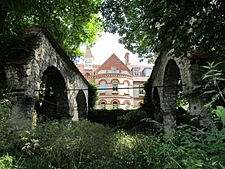Hospital of St John the Baptist, High Wycombe facts for kids
Quick facts for kids Hospital of St John the Baptist |
|
|---|---|

The remains of the 12th Century Hospital of St. John the Baptist, High Wycombe
|
|
| Geography | |
| Location | High Wycombe, England, United Kingdom |
| Organisation | |
| Funding | Charity |
| Services | |
| Emergency department | No Accident & Emergency |
| Helipad | No |
| History | |
| Founded | 1180 |
| Closed | 1548 |
The Hospital of St John the Baptist was an old hospital in High Wycombe, England. It was open from 1180 to 1548. You could find it on the main road between Oxford and London, which is now the A40.
Contents
The Hospital's Purpose
In the 1100s, hospitals were often like special homes for people who were poor or sick. They were called almshouses. The Hospital of St John the Baptist was started by the church. It was run by a Master, who was usually a monk or another religious person. A small group of brothers and sisters from the church also helped. They looked after people who needed care.
The hospital also kept three beds ready for poor or sick travelers. These travelers were passing through on the road to London or Oxford.
Building a Chapel
The first Master we know about was Brother Gilbert. In 1236, he wrote to Pope Gregory IX in Rome. He asked for permission to build a chapel at the hospital. This chapel would be dedicated to St John the Baptist. The Pope agreed in 1239, and the chapel was built soon after. We don't know if the hospital was named after St John the Baptist at this time, or if it already had that name.
The Hospital Closes
The hospital kept running until the mid-1500s. This was during a time called the Dissolution of the Monasteries. During this time, King Henry VIII took all the property belonging to the Catholic church. The hospital officially became the King's property. It became very hard for the hospital to keep going. It finally closed in 1548. The last person to run the hospital was Charles Chalfont, from 1541 to 1548.
From Hospital to School
In 1550, the mayor and important people of the town bought the hospital buildings. They wanted to start a school there. Boys could join the school by paying a fee. They learned important subjects like reading, writing, math, and classic studies. Most of the boys who went to this school would then go on to university, probably at Oxford.
The Royal Grammar School
In 1562, the school received a special document called a Royal charter from Queen Elizabeth. This meant the Queen officially approved and supported the school. From that day on, the school was known as the Royal Grammar School. It still has that name today!
The school used the old hospital buildings until 1883. Then, enough money was found to build a new school. This new building was put just north of the old hospital. The ancient hospital building was then taken down. In 1915, the school moved again. It moved to its current location on Amersham Hill.
A Protected Ruin
Part of the original hospital building was pulled down in 1767. This was to make the main road wider. The road was being turned into a turnpike, where people paid to use it. The south wall of the hospital's main hall was removed then. The hall became shorter, from 15 meters to about 12 meters.
When the school moved out, most of the remaining hospital buildings were taken down. But some parts were left standing. These include the north wall and five columns from the hall. These columns have four arches with cool decorations from the 1100s. Also, part of the north chapel wall with two half lattice windows from the 1200s or 1300s still stands. These old ruins are still there today.
Protecting the Ruins
In the late 1800s, the remaining ruins were made stronger. Brick buttresses (supports) were added. In the early 1900s, the columns and walls were given stronger foundations made of cement.
In 1993, the ruins were named an English national monument by English Heritage. This means they are an important historical site and are protected. Today, they are well cared for and are lit up at night. This makes them a special landmark in the area.

